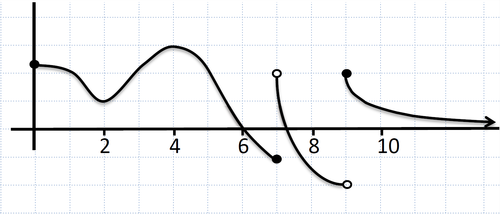Science:Math Exam Resources/Courses/MATH104/December 2015/Question 06 (a)
{{#incat:MER QGQ flag|{{#incat:MER QGH flag|{{#incat:MER QGS flag|}}}}}}
• Q1 (a) • Q1 (b) • Q1 (c) • Q2 (a) • Q2 (b) • Q3 (a) • Q3 (b) • Q3 (c) • Q4 (a) • Q4 (b) • Q4 (c) • Q5 (a) • Q5 (b) • Q5 (c) • Q6 (a) • Q6 (b) • Q7 • Q8 (a) • Q8 (b) • Q8 (c) • Q9 • Q10 (a) • Q10 (b) • Q10 (c) • Q10 (d) • Q11 •
Question 06 (a) |
|---|
|
Below is a graph of  (i) What is the global maximum value? (ii) State the -value(s) where a local minimum occurs. |
|
Make sure you understand the problem fully: What is the question asking you to do? Are there specific conditions or constraints that you should take note of? How will you know if your answer is correct from your work only? Can you rephrase the question in your own words in a way that makes sense to you? |
|
If you are stuck, check the hints below. Read the first one and consider it for a while. Does it give you a new idea on how to approach the problem? If so, try it! If after a while you are still stuck, go for the next hint. |
Hint 1 |
|---|
|
Recall that a global maximum is a value of for which for all in the domain of |
Hint 2 |
|---|
|
Recall that a local minimum is a value of for which for all in some open interval centred at , i.e., an interval of the form |
|
Checking a solution serves two purposes: helping you if, after having used all the hints, you still are stuck on the problem; or if you have solved the problem and would like to check your work.
|
Solution |
|---|
|
(i) Visually speaking, we can find a global maximum of by searching for the highest "y-value" attained by its graph (see hint 1 for a precise definition). We see that it is (which occurs when , although this information is not necessary here). Hence (ii) Local minima of appear as 'valleys' in its graph (see hint 2 for a precise definition). We see that local minima occur at Note: The point looks tempting, but note that , which is certainly not less than or equal to values of nearby. We also cannot choose something "just to the left of 9", e.g., , since we will always be able to find a value of closer to 9 for which is smaller (e.g., ). |
{{#incat:MER CT flag||
}}


















